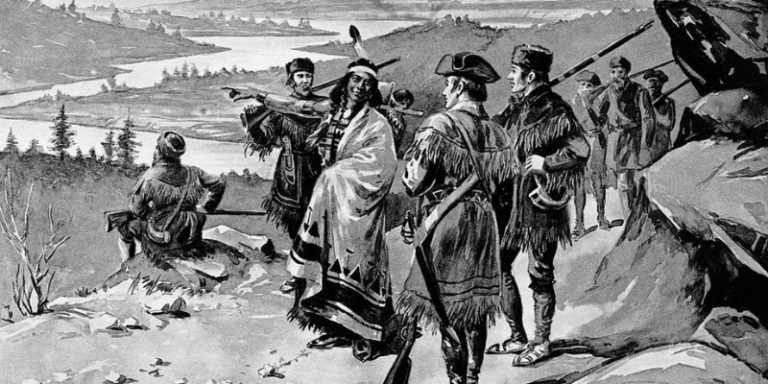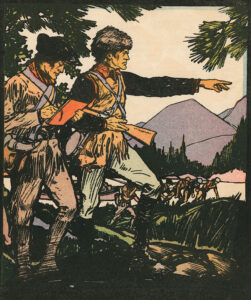Lewis and Clark: Blazing the Trail West
After the Lewis and Clark expedition, thousands of people headed west to settle.
By: James Fite | August 22, 2020 | 475 Words

Lewis and Clark drawing by Alfred Russell (via Getty Images)
When the United States bought the Louisiana Territory from France in 1803, it nearly doubled the size of the nation. But after the Louisiana Purchase, someone needed to explore all that extra land. President Thomas Jefferson sent Captain Meriwether Lewis, who had served as his personal secretary, to lead an expedition across the new land. Lewis chose Second Lieutenant William Clark to help him lead, and on May 14, 1804, they set out with a 41-man crew of explorers from Camp Dubois just outside St. Louis, Missouri, heading for the Pacific Ocean.
The Northwest Passage
Many people believed in a navigable water passage that connected the Atlantic Ocean to the Pacific. When Jefferson sent the Lewis and Clark expedition west, he hoped that they could find it. Today, we know that there is no such passage. But the team had several other goals, as well. They were to explore and create a map for the new territory, which they did. They also were expected to get to Oregon so the United States could officially lay claim to the area before Britain could – again, they were successful. They also kept detailed records of all the unknown creatures and plants they found along the way, and they worked to establish peaceful trading relations with the Native American tribes across the country.
Sacagawea’s Contribution

(Photo by GraphicaArtis/Getty Images)
Lewis and Clark needed a guide and a translator for their long trip west, and Sacagawea was the person who filled both roles. The Shoshone tribeswoman was pregnant when they left, and she had her baby on the trip. While she translated and helped navigate, just being there with her child was also very important. The various Native American tribes they met along the way saw her presence as a sign of peaceful intentions. If Sacagawea and her child had not been in the group, the Lewis and Clark expedition might have turned out very differently, especially if any one of the many tribes they met had not been so welcoming and helpful to them.
The Lewis and Clark Legacy
The expedition may not have found a navigable water path connecting the two oceans, but they did make it to Oregon and the Pacific, where they camped for several months before making the return trip.
When they made it back east in 1806, they brought back a claim on the west coast, a travel route to get there, peaceful relations with the people who lived along the way, and many pages of new information to be studied. When they returned to St. Louis, no one had heard from them in over a year and they had been given up as dead. Had they never left to begin with – or had they truly been lost on the way – the nation would likely look very different today.
















